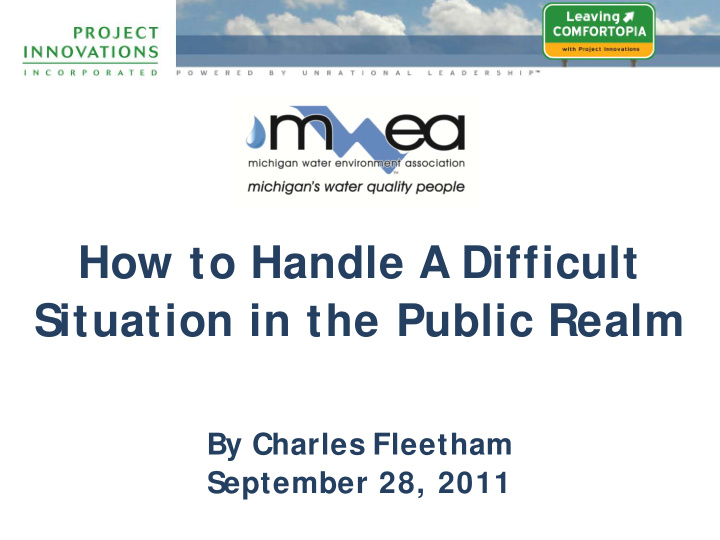



How to Handle A Difficult Situation in the Public Realm By Charles Fleetham September 28, 2011
Project Innovations, Inc. Founded in 1992, located in Farmington Hills, Michigan Page 2
Page 3
Page 4
We Help You Leave Comfortopia Page 5
Here we go . . . Sometimes just doing your job makes citizens unhappy. Page 6
And bad feelings result - Hos ostile Ashamed Disgusted Disgusted Aggressive Cold Co threat eaten ened Suspicio icious Victimized Guilty vulnerable Page 7
And it’s difficult to deal with unhappy people when they are on their home turf. Territoriality increases energy – defensiveness, self-righteousness and even physical characteristics such as voice and posture. Page 8
Five ideas for dealing with a difficult situation in a public setting: 1. Quickly get an understanding of the situation – it’s a potential conflict! 2. Warm up your voice. 3. Get command of yourself. 4. Deliver the news. 5. Bring them down the ladder. Page 9
1. Get an understanding of the situation. Ladder of Conflict Escalation Needs at stake If you go up here, you lose WAR Fight or flight Citizen climbs here Help! Conflict to ? Disagreement Goal: Bring to solve citizen down Latent You are here the ladder or disagreement don’t let No disagreement him/her get Interests at stake any higher. Page 10
2. Warm up your voice . . . It’s your best asset. • Pretend your are chewing a big wad of gum and stretch out your mouth. • Hummmmmmmm . . . . • Tongue Twisters - Unique New York, toy boat, rear wheel drive Sing . . . “ Do, Re, Mi, Fa, So, La, Ti, Do” • • Exercise your volume Page 11
3. Get command of yourself. 1. Take a deep breath. 2. Don’t stiffen . . . bend your knees. 3. Stay ready – get balanced on the balls of your feet. 4. Remind yourself “it’s not personal”. Page 12
4. Deliver the news. • Do you know why I’m here? (standard law enforcement technique that focuses citizen on issue – not you.) • Assuming unhappy response – explain why you are here – ending your request with minimal amount of facts (it’s very easy to confuse someone who is already “unhappy”.) • Confirm the citizen understands your “news”. Page 13
5. Bring them down the ladder. 1. Don’t mix personality with the process . . . avoid “you” . . . stick with “this issue needs.” 2. Acknowledge unhappy feelings and wait for confirmation. 3. Save the citizens face – ask: “How can THIS be resolved most effectively?” Page 14
And don’t forget to watch for ticking time bombs. Identifying a Ticking Time bomb: • Most often males between ages of 30 and 40 • Other employees concerned • Threats have been made • Obsession with violence/ causes • S ocially isolated • Habitual complainer (angry) Page 15
How to Deal with a Difficult Situation in the Public Realm 1. Quickly get an understanding of the situation – it’s a potential conflict! 2. Warm up your voice. 3. Get command of yourself. 4. Deliver the news. 5. Bring them down the ladder. Page 16
Recommend
More recommend